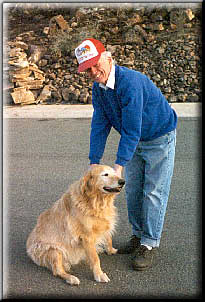Gaining Strength With Lovastatin
William "Bill" Dunn, a 68-year-old husband, father of four, grandfather to two and Navy veteran, was diagnosed with malignant pleural mesothelioma on June 9, 1998. Bill's story is unusual in two respects: he lost his right leg as a consequence of mesothelioma; and he has survived mesothelioma with the help of Lovastatin, a drug used to treat high cholesterol.
Initial Impression: Pneumonia
In December, 1997, Bill presented to his personal physician with a productive, insistent cough. His doctor prescribed antibiotics, but the cough persisted. Bill returned to his doctor, who ordered chest films taken the same month at Yavapai Regional Medical Center in Prescott, Arizona. The films showed a shadow on the right side. His doctor felt this was pneumonia. Bill's cough persisted, and he returned to his doctor, who ordered repeat chest films sometime in January or February, 1998. The shadow on the right side had not diminished, which troubled Bill's physician. He ordered a CT scan, taken on February 13, 1998. The CT scan showed what appeared to be a right-sided pleural effusion.
On March 24, 1998, a surgeon performed a CT-guided biopsy. An incision was made in the area of the right shoulder blade. A tube was inserted, then an instrument to remove biopsy samples. The surgeon detected pleural thickening. He harvested biopsy tissue. On March 24, 1998, the pathology department found that mesothelioma could not be ruled out. As the pathology report recited, "The scant fragments of mesothelia provided interferes with complete evaluation and hinders a definitive diagnosis." However, no one communicated the ominous findings to Bill.
Pleuracentesis and Pleural Biopsy
Bill was then referred to thoracic oncologist Dr. Louis Lanza to treat his pleural effusion. He was to be worked up for a thoracoscopic biopsy in the ensuing days at the Mayo Clinic in Scottsdale. He went there as scheduled on April 14, 1998.
Bill was incidentally complaining of pain in his right foot, and was referred to a Dr. Fowl, a vascular surgeon. Dr. Fowl ran a preliminary test, underestimated the seriousness of the problem, and told Bill to come back in two days. When Bill was walking his dog the next day, he developed severe pain and obtained a same day, after-hours appointment with Dr. Fowl. Dr. Fowl examined Bill, again failed to appreciate the situation's gravity, and told him to return for testing the next day, as scheduled previously at Scottsdale North Hospital.

Bill came to Scottsdale North the next day as directed. A nightmarish series of medical complications related to his as-yet undetected mesothelioma ensued, culminating in the surgical amputation of his right leg above the knee.
Blood Clot from Tumor Results in Leg Amputation
Over the next seven days, Bill underwent five surgeries. Bill says, "It's the worst pain I've ever endured." As Dr. Fowl explained it to him after his diagnosis of mesothelioma, the cancer caused a plaque to form on the aorta, which then broke loose and traveled down his right leg. After the April 25 surgery, another clot developed in the left leg, but fortunately Bill's doctors were able to save his left leg. Bill now has a prosthetic lower right leg.
After the amputation, Bill finally met with Dr. Parish at the Mayo Clinic in Scottsdale. On June 1, 1998, Dr. Parish performed a thoracentesis. The cytology was non-diagnostic. A thoracoscopic biopsy with talc pleuradesis was performed on June 5, 1998 by Dr. Lanza at Mayo. No pleurectomy or decortication was performed. The diagnosis of mesothelioma was given to Mr. Dunn on June 9, 1998. Dr. Thomas Colby, a member of the US-Canadian Mesothelioma Panel, confirmed the diagnosis. Bill's doctors discussed several options, including chemotherapy, radiation therapy and other adjunctive therapies. However, they did not seem enthusiastic about Bill's chances.
Undaunted, Bill set to work researching the Internet for alternative treatments. (Bill "customized" his prosthetic leg through the Internet, selecting the knee and foot to be used.)
Bill Discovers Lovastatin
Bill's internist, Dr. Joseph P. Griffin, reviewed a 1998 medical article regarding the treatment potential of Lovastatin, a drug used to treat high cholesterol and possible angiogenesis inhibitor. In their study, Dr. Rubins and his colleagues treated mesothelioma cells and normal lung cells with Lovastatin. The mesothelioma cells stopped growing and started to die, a process known as apoptysis. But normal cells were unaffected. Interestingly, since the Rubins article in 1998, there have been no follow-up publications, despite the popularity of the drug among mesothelioma patients.
Dr. Griffin felt that Lovastatin certainly would not hurt. Bill's daughter, a nurse, also recommended Lovastatin. Bill's niece's husband, Dr. David Flockhart, heads the Department of Pharmacology at Georgetown University. He gave Bill "the green light" to proceed with Lovastatin.

Bill takes one 20 milligram tablet a day of Lovastatin. He uses the brand Mevacor, manufactured by Merck. He reports that a two month supply costs about $125 to $130. He reports no side effects from the medication, and feels relatively good. In fact, at his latest examination, his doctor remarked, "Whatever you're doing, keep it up!"
Bill is limited in his exercise options by his surgical amputation. He works out with five-pound dumbbells to keep his upper body fit. He gets out for three-quarter mile "walks" in his wheelchair with his eleven year-old golden retriever, Pal.
Adjusting to Life With mesothelioma and a Handicap
It has not been easy for Bill. In addition to the above-the-knee surgical amputation, his mesothelioma has plagued him in other ways. He has had to take steroids and antibiotics from a lung infection suffered during his hospitalization for the amputation. Because of the blood clotting problem caused by his tumor, doctors prescribed a blood thinner, Heparin, which had the side effect of causing osteoporosis. Bill has struggled with his balance since the amputation. One day he fell, suffering four compression fractures of the spine, resulting in the loss of three inches in height. His doctors put him on medication to strengthen his bones. All of these things took a toll on Bill's weight. Normally 150 pounds, he lost 20 pounds with the loss of the leg. His weight afterwards dipped as low as 109 pounds, and has gotten back to 125 pounds with some effort.
Bill and his wife have been married for 46 years. After years of work in computer software sales, Bill retired in 1994. Since then, and before he was stricken, he had donated his time and energy to various charities, including St. Vincent DePaul, "Meals-on-Wheels", and Golden Age (food for the poor). Now, with his balance and other problems, Bill can no longer serve others as he would like. We will keep you posted on the progress of this charitable and inspiring man.
*** POSTED MARCH 29, 2000 ***
Mr. Bill Dunn passed away on December 18, 2000

